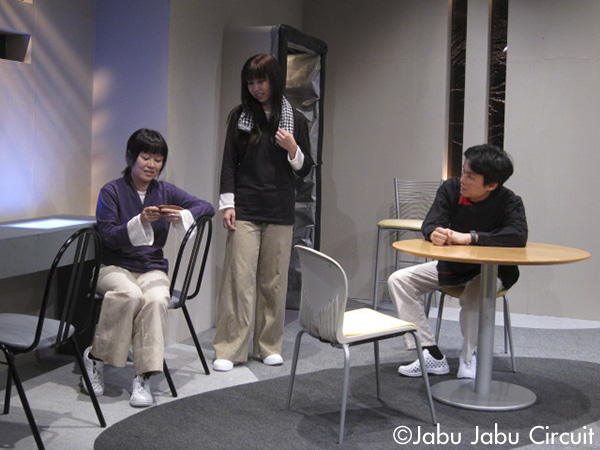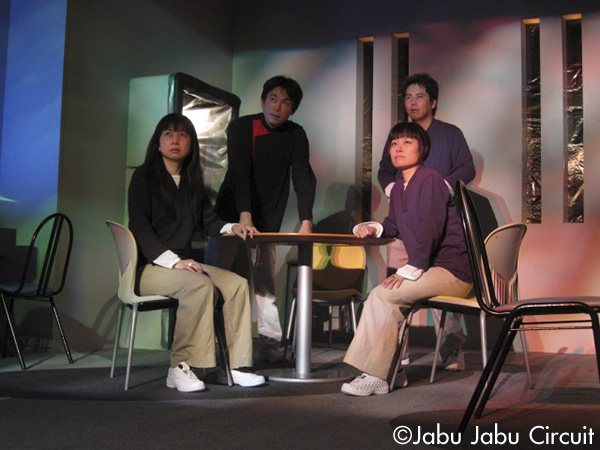

Theater company Jabu Jabu Circuit 50th anniversary production
Zero-Gravity Children
(Jun. 23 – 26, 2011 at Nanatsudera Kyodo Studio)
Data
:
Premiere: 2011
Zero-Gravity Children

Hase was born in Gifu Prefecture. After graduating from Gifu University in 1984, he worked for a local newspaper and also founded the theater company Jabu Jabu Circuit. Since 1989 he has focused on writing and directing plays, and on fronting the theater company. Operating from a studio in a rural area, Hase enjoys a pace of life that enables him to dedicate his time to creating a wide range of plays from children’s tales to mysteries and even psycho horror. Several of his plays have been shortlisted for the Kishida Drama Award, including Daburu feiku (Double Fake) in 1999, Saiko no bansan (Psycho Supper)—a play he wrote for another theater company about a strange all-female commune—in 2005, and Hizumitagaru tairetsu (Distorted Ranks) in 2007. Hase has written over 90 plays in all, and is actively working to take local theater to a national level.


Theater company Jabu Jabu Circuit 50th anniversary production
Zero-Gravity Children
(Jun. 23 – 26, 2011 at Nanatsudera Kyodo Studio)
Data
:
Premiere: 2011
The year is 2085 and a colony has been built on the Moon for an international group of scientists to pursue their research in long-term residencies. The research is carried out with international cooperation but the residences are separated by nation. In the Japanese residential block live the team leader, Kanamori and three female research team members, Maki, Kotone and Haruka. Although there is some degree of solidarity as compatriots, in reality most of their time is spend working in their individual areas of research specialization.
One day a young man named Shoji arrives to join the team. But, there is something suspicious about the woman who brings him to the colony. Neither Maki nor Kotone who are there when they arrive have ever seen her before. When they ask who she is, she explains that she is a Myu, which is some kind of fluid intergalactic life form. The Myu are a highly intelligent life form that can morph at will into any form they wish. She begs them to let her stay there for a while in anonymity. The Myu takes the form of Kanamori’s estranged wife Masako and takes up residence in a corner of the Japanese block by creating a situation where it is difficult for him to refuse.
As the team is wondering how to deal with this fluid life form, an alarm runs through the colony. On Earth, Japan’s capital has been hit by a devastating earthquake on the scale of the great earthquakes of 2011 and 2062. The magnitude registers 9.3 on the Richter Scale.
In the colony the question of how the World Federation should aid Japan becomes a top issue. But, the debate drifts toward the worldwide political and economic effects and away from immediate aid to the disaster victims. Over drinks in their own residential block, the Japanese team gives voice to their disappointment with this response.
We learn that Maki became a devoted volunteer in relief work after losing her parents in a previous earthquake. In contrast, Haruka suffered from anorexia after being hurt by the irresponsible statements of people who were not actual victims of an earthquake. And we learn that Kotone has had to live with the memory of being victimized by swindlers who used the disaster as a means to exhort money from her. Then there is Kanamori who thinks his ex-wife may have died in this earthquake.
As leader of the Japanese scientific team in the Moon colony, Kanamori has the job of sending a message to middle school students in the areas stricken by the earthquake. Kanamori tells the children that, rather than depending on the politicians or other adults they should learn to anticipate what the future will bring. Next he says that he hoped they would acquire true intelligence with the ability to think about what will happen to the world even after they die. He goes on in his awkward way to say that rather than criticizing others they should consider the fact that there may be a troublesome person within themselves. The other adults object to this speech but the children have loved it.
It turns out that the pleading of the Myu to be taken in was a guise and its true purpose has been to observe these human beings from planet Earth. The Myu has decided neither to morph into a human and aid them nor to discard them, but to put things on hold for the time being. Before the Myu leaves, Kanamori asks it two questions: what the Earth and its people need and whether or not his ex-wife has died in the earthquake. To the first question, the Myu answers, “a philosophy of laughing and accepting the hopelessness of one’s situation.” To the second question it responds by thanking Kanamori for opportunity to morph into his former wife. With those words the Myu departs.
Kanamori is left pondering the sight of the distant Earth.
Related Tags